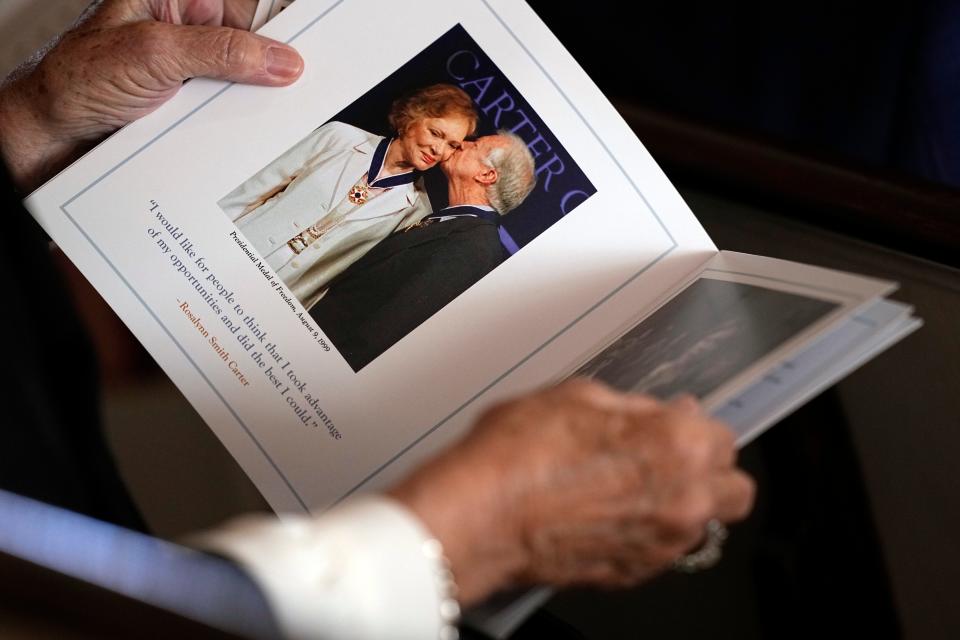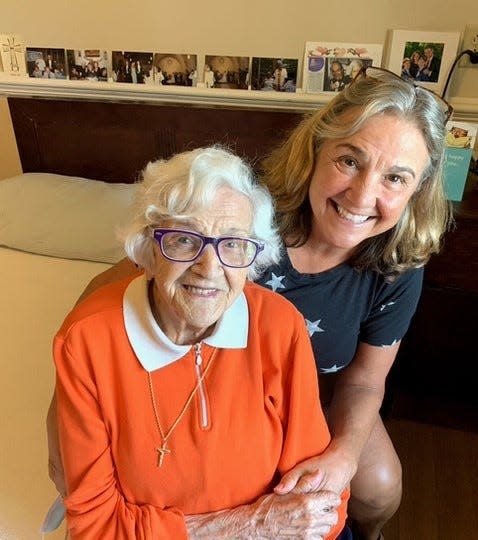Rosalynn and Jimmy Carter bring needed attention to hospice care – and questions
- Oops!Something went wrong.Please try again later.
- Oops!Something went wrong.Please try again later.
Former President Jimmy Carter entered month 10 on home hospice care just as former first lady Rosalynn Carter entered hospice on Nov. 17 and died in days.
Generally, people associate hospice with imminent death, especially if they have no close experience with it. And in many cases they are right: Out of the more than 1.5 million choosing hospice services in America, half die within 18 days of admission to hospice, and 1 in 10 die in the first two days.
The Carters perhaps will join other longtime couples who die within days to months of each other. But the drastic difference in their lengths of hospice care brings attention to this question: Can someone "outlive" their hospice stay?
End-of-life care advocates have championed the Carters' willingness to publicly share their decision to enter hospice because it brings needed education and attention to the extended benefits of hospice care, such as home visits from interprofessional team members, equipment and supplies, and access to on-call support. But what happens when someone enters hospice expecting to live six months or less – a requirement for admission – and then does not die?

'This is not good news to me, my family or my mother'
The simple answer is that hospice patients must be reevaluated for care every 90 days within the first six months, and then every 60 days thereafter, with a physician documenting that the patient remains eligible.
However, recertifying patients for care, or removing them from care if their condition is not declining, is anything but simple. Jean Bowman, the daughter of a 104-year-old patient living with Alzheimer’s disease who was removed from hospice in June – despite Jean’s wishes – knows this all too well.
In a letter sent to Medicare to appeal the discontinuing of her mother's hospice services, which she first began receiving in July 2020, Jean wrote, “I am told that this is good news since her weight is stable, her meds are stable, and she has no acute needs. This is not good news to me, my family or my mother.”

She detailed the services that were a lifeline to her and her mom: Nurse visits about care needs; social work visits that helped their family interact and connect despite her mother’s declining mental status; spiritual support and prayers; and the routine bath and hygiene visits from the aide whom her mother referred to as “her special friend.”
Though Jean acknowledged her mom’s stability physically, she questioned whether hospice evaluated her mental and psychological deterioration in the decision – issues that are exacerbated with changes in routine such as the discontinuation of the hospice providers she had become accustomed to.
Support caregivers: We must ensure that our older generations get economic security and the care they deserve
'Hospice' and 'death' are not dirty words
Ultimately, I wonder whether there are additional questions we should be asking beyond what happens to people if they live “too long.”
These concerns include whether hospice is appropriately structured to care for people dying from chronic illnesses – heart disease, cerebrovascular disease and Alzheimer’s disease all fall in the top causes of death for those 65 and older – when it is nearly impossible to predict when they are six months from death.
Hospice care focuses on quality of life and addresses the symptoms of an illness, rather than treating the disease itself. This focus of care makes patients feel better, as they remain at home instead of going in and out of the hospital on a repeating loop – a driving reason for the former president’s decision to enter hospice – and centers on making them feel the best they can for the remainder of their life.
Rosalynn Carter: From mental health to Camp David to the campaign trail, she made her mark
Research shows that when you compare patients who use hospice with those who do not – matched by demographics such as age, race, gender and diagnosis – the hospice patients live longer.
It might be the hospice care itself that helps a patient’s condition stabilize, eventually rendering them ineligible to continue receiving care.
Though imminent death is assumed when most people hear someone has entered hospice, longer stays provide greater benefits to patients and families, including less pain, better symptom management overall and more attention to their end-of-life wishes.
Opinion alerts: Get columns from your favorite columnists + expert analysis on top issues, delivered straight to your device through the USA TODAY app. Don't have the app? Download it for free from your app store.
Even when people enter hospice believing that it is primarily about death, their experience with care might change their perceptions – to understanding hospice based on dignity, positive relationships with staff, and peace.
With this perspective it is easy to see why at least three months is suggested as an optimal length of time for hospice care, and why it is such a difficult benefit to lose when a patient is removed from care.
Hospice was a grassroots effort, initially falling outside of the traditional medical system and only formalized in U.S. policy in 1982, a year after former President Carter left office.
A lion at dusk: Jimmy Carter's greatest accomplishments have been in health and welfare
Though it has been more than 40 years since hospice was established in health care policy, we still have a long way to go before it is fully embraced by patients, families, clinicians and communities.
There is power in public voices, including Jean Bowman’s from her failed appeal to Medicare on behalf of her mother: “If reaching the age of 104 is not your definition of end of life we need to be thinking of how to change that definition and bring comfort and care to those who need it.”
"Hospice" and "death" are not dirty words. Perhaps the more we talk about them, the better off we all will be – in life and in death.

Cara L. Wallace, the Dorothy A. Votsmier Endowed Chair, is a professor at the Trudy Busch Valentine School of Nursing at Saint Louis University in Missouri.
You can read diverse opinions from our Board of Contributors and other writers on the Opinion front page, on Twitter @usatodayopinion and in our daily Opinion newsletter.
This article originally appeared on USA TODAY: Jimmy Carter's care raises question: Can you outlive hospice?

